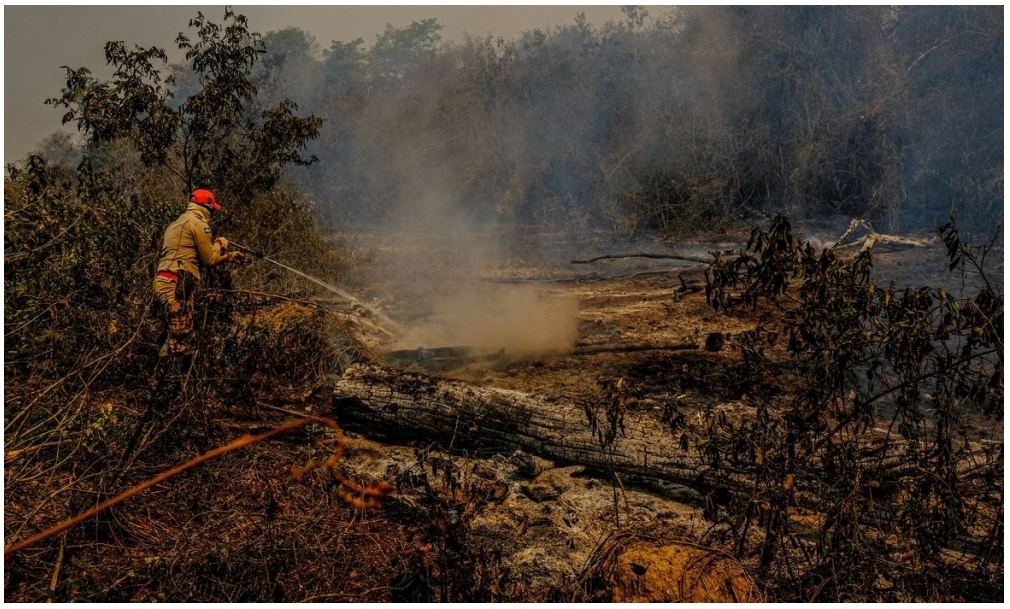May 25 2021
The severe drought experienced by the Pantanal between 2019 and 2020 is believed to be the worst in the last five decades. It was triggered by natural climate conditions that were analogous to those that caused the 2014–2016 critical water crisis in São Paulo state.
 The study shows that the 2019–2020 drought resulted from a natural meteorological phenomenon similar to the one that caused the 2014–2016 critical water shortage in São Paulo state, Southeast Brazil. Image Credit: Mayke Toscano/Secom-MT.
The study shows that the 2019–2020 drought resulted from a natural meteorological phenomenon similar to the one that caused the 2014–2016 critical water shortage in São Paulo state, Southeast Brazil. Image Credit: Mayke Toscano/Secom-MT.
The Pantanal is one of the largest wetlands in the world. The Brazilian part is situated in the Center-West area, chiefly Mato Grosso do Sul state.
The severe drought, which occurred in 2019–2020, was investigated by scientists affiliated with the Natural Disaster Surveillance and Early Warning Center (CEMADEN), the National Space Research Institute (INPE), and São Paulo State University (UNESP) as part of a study funded by FAPESP under the guidance of its Research Program on Global Climate Change (RPGCC).
The study results have been published in the Frontiers in Water journal.
“The recent drought in the Pantanal was caused by a meteorological phenomenon we call atmospheric blocking. A high-pressure area prevented the formation of rainclouds throughout the central-western portion of South America. Temperatures were very high and relative humidity very low,” José Marengo, the principal investigator of the study and researcher from CEMADEN, informed Agência FAPESP.
“Lack of rain combined with high temperatures and very low humidity led to a heightened risk of fire, which extended to agricultural areas as well as natural parts of the biome,” added Marengo.
Vegetation was deliberately burned to clear land for cattle ranching, and this played a major role in spreading wildfires across the region. But these fires could not be easily controlled because of the extended period of drought.
Fires caused on one hand by warmer air and lack of rain in the Pantanal, and on the other by the burning of areas to clear the vegetation for cattle to graze, resulted in environmental disaster.
José Marengo, Study Principal Investigator and Researcher, Natural Disaster Surveillance and Early Warning Center
Sources of Observational Data
To analyze the hydroclimatic causes of the Pantanal drought, the investigators employed a range of sources of observational hydrological data (on the capacity of the Paraguay River) and also used data on hydroclimatic teleconnections (associations between atmospheric circulation patterns and hydrological events that cause weather phenomena) and rainfall.
The team even used remote sensing data and land use data to define drought and water stress in the Pantanal.
After analyzing all these datasets, the researchers were able to clearly describe the drought-related factors, river streamflow, and interannual variability of rainfall. They concluded that the drought was induced by a complex mixture of hydroclimatic teleconnections.
The lack of rain during the summer in 2019 and 2020 in the Pantanal was due to a decrease in the flow of warm humid air from the Amazon.
José Marengo, Study Principal Investigator and Researcher, Natural Disaster Surveillance and Early Warning Center
Part of the rain falling on the Pantanal is caused by winds that blow from the North Atlantic to the Amazon, and from there travel toward the Pantanal located in the Center-West area of Brazil. A high-pressure bubble prevented the cold fronts coming up from the South as well as the humidity coming down from the Amazon from reaching the Pantanal.
Consequently, masses of drier and warmer air played a key role in the scarcity of rain during the summer period at the peak monsoon season. This season is generally defined by variations in atmospheric circulation as well as precipitation in subtropical and tropical coastal areas caused by asymmetric heating of sea and land.
The outcome was a prolonged severe drought across the Pantanal, with extremely adverse impacts on the biome.
“This phenomenon is natural and occurred in a similar manner in São Paulo during the 2014-16 drought,” added Marengo.
Amplified Impact
Marengo believes that it is still not viable to predict whether the Pantanal will suffer more extreme droughts in the days to come. The issue can only be prevented as long as the right amount of rain occurs at the right time.
It’s no use getting rain now, in March, at the end of the rainy season, and then between December this year and February 2022, for example. This compromises the rainy season and increases the risk of more wildfires in the Pantanal.
José Marengo, Study Principal Investigator and Researcher, Natural Disaster Surveillance and Early Warning Center
In the Pantanal, drought cannot be blamed exclusively on global climate change because this event is natural and climate change happens to be a long-term process. The latest drought was different from those witnessed in the 1950s and 1960s when the Earth was cooler.
“What’s happening now is that these natural droughts are suffering the effects of climate instability, and the effects are worse because back then there was a lot less human occupancy in the region. Its population is now more vulnerable to the impact of drought,” concluded Marengo.
Journal Reference:
Marengo, J. A., et al. (2021) Extreme Drought in the Brazilian Pantanal in 2019–2020: Characterization, Causes, and Impacts. Frontiers in Water. doi.org/10.3389/frwa.2021.639204.